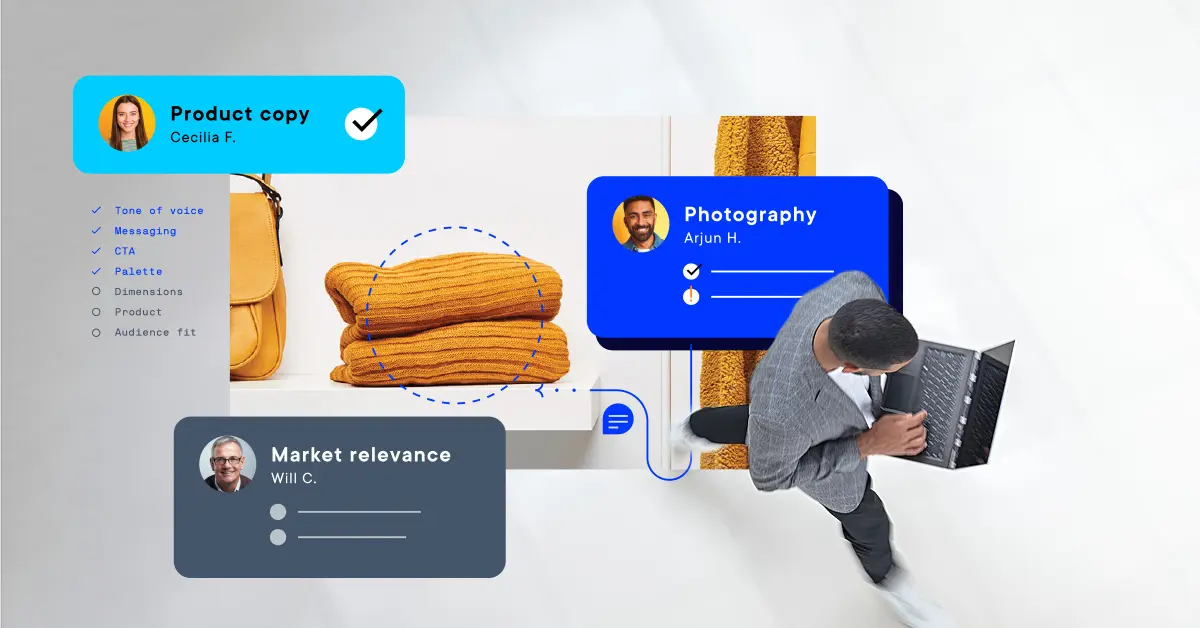Creative asset management: What it is and why it matters
Learn how creative asset management software can streamline your workflows, boost collaboration, and increase value for users.

Flip over your phone real quick. What do you see?
An apple?
A “G”?
A 1+?
Those symbols and letters mean something to you. They symbolize quality, innovation, and reliability.
But imagine if you flipped over your phone right now and saw a logo of a coconut.
And what if the “G” was in a Times New Roman font?
You’d likely have a difficult time connecting that coconut to Apple or that serif typeface to Google.
They wouldn’t mean much to you—they wouldn’t represent excellence, cutting-edge, or anything that those brands stand for.
Creative asset management ensures your brand and creative assets stay consistent.
Beyond brand control, digital asset management empowers your creative teams (from your marketers to your designers) to streamline their content creation and execute high-quality campaigns at scale and at tip-top speed.
But we’re getting ahead of ourselves.
First, you probably want to know exactly what we mean when we say creative asset management.
What Is Creative Asset Management?
Creative asset management refers to software that streamlines your marketing campaign and content lifecycle by combining all your digital assets, workflows, and teams into one platform.
Yeah, that’s a mouthful.
In a nutshell, a creative asset management platform should help your business with the following:
- Store, share, and reuse digital assets
- Track version, history, and usage of every marketing asset
- Create automated workflows to simplify and expedite processes
- Maintain brand control and messaging consistency
- Repurpose assets to maximize content and stretch your budget
Why All the Excitement About Digital Asset Management?
Digital asset management isn’t a nice-to-have—it’s a need-to-have (especially in 2021). Digital repositories are great, but they’re not enough.
The State of Digital Asset Management report shows 51% of marketers waste money creating (or recreating) assets that go unused because coworkers can’t find them or don’t know they exist. Another 40% claim their company has no single source of truth for assets, making it difficult to locate the right digital assets.
Your business needs an easy way to plan, create, store, share, track, and measure your creative assets.
Here are just a few ways digital asset management software can forever change your workflows and creative lifecycles.
- Accelerate content creation by automating workflows and staying organized.
- Prevent digital assets from disappearing into the dark depths of repositories—never to be seen again.
- Maintain brand consistency by providing your teams with the most up-to-date, high-quality creative assets.
- Prove (instead of promise) results with data to validate the efficiency and effectiveness of your campaigns and creative projects.
Each of these benefits alone is worth considering a creative asset management platform.
Collectively? Now, it’s a no-brainer.
Top 4 Ways Creative Asset Management Software Will Change Your Workflows (Forever)
Let’s get into the nitty-gritty of each of the benefits we mentioned above. Below, we’ll show you exactly how creative asset management software can benefit your company.
And we’ll back up the claims with Welcome’s software functionality.
1. Accelerate Content Creation to Tip-Top Speed at Scale
No more sitting around waiting for your designer to send you the link to the campaign’s updated video assets or marketing images.
With a digital content management system, you have immediate access to all the marketing materials you need to do your job.
- Get organized: Create and store digital media with intuitive tagging to make it easy to find the exact file you need.
- Stay up-to-date: Welcome leverages powerful editors to let you annotate and version your digital files, as well as track every asset’s progress and history.
- Automate workflows: Expedite the creative process with customizable workflows and dozens of distribution integrations.
Welcome does all of the above and more to streamline your creative process. Learn how Welcome expands creative teams’ bandwidth by empowering marketers to leverage existing assets more effectively.
2. Prevent Digital Assets from Disappearing Forever
Designers and marketers spend hours, days, and even weeks producing top-notch content for marketing campaigns and business initiatives. However, once those campaigns conclude (and sometimes even before they’re completely done), the creative assets are filed away somewhere in the cloud.
And once they go into the cloud archives, they usually don’t come out—ever.
But these assets are still valuable. They can be reused and repurposed in a variety of use cases, extending their lifecycle and saving you valuable time and budget.
Welcome lets your teams easily tag, store, and search for digital assets to extend the life and effectiveness of every creative file.
3. Maintain Your Brand Integrity Across the Digital (and Physical) World
Remember that time when a teammate sent out an important press release to dozens of news outlets with your company’s old logo?
With creative asset management, that’ll never happen again.
A platform like Welcome will empower your teams to find the right brand files with asset versioning and utilization tracking.
- Utilization tracking: Track how every asset is used. If Jared on the PR team downloads the company’s original 2010 logo, you’ll know about it right away.
- Proofing and annotations: Add context and clarity to every asset. Some assets will be campaign-specific, while others will serve a more evergreen purpose—attach all the relevant documents, metadata, details, and history to each file to eliminate confusion.
- Version control: Guarantee your teams are editing and using the most up-to-date assets to ensure files aren’t lost (and used appropriately) and that work isn’t unnecessarily duplicated.
4. Prove (Not Just Promise) Results
Asset management systems are well worth the investment. We know it, but does your boss know it? What about the CMO?
With data-backed results and real-time tracking, you don’t have to write any lengthy emails to your marketing department explaining how asset management transformed your creative workflows—the numbers will do all the talking for you.
- Time tracking and reporting: Measure how your production team spends their time to avoid overcommitting or duplicating work.
- Track content utilization: Monitor team members using creative assets (and how) to measure their long-term effectiveness and value.
- Upgrade your SLAs: Set and measure more accurate Service Level Agreements to avoid bottlenecks, improve your workflows, and ultimately reach your goals.
